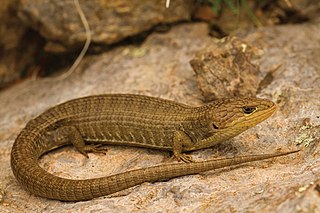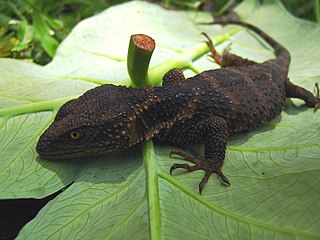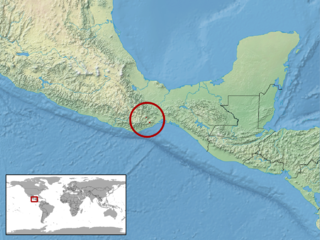
Xenosauridae is a family of anguimorph lizards whose only living representative is the genus Xenosaurus, which is native to Central America. Xenosauridae also includes the extinct genera Exostinus and Restes. Also known as knob-scaled lizards, they have rounded, bumpy scales and osteoderms. Most living species prefer humid, rocky habitats, although they are widespread within their native regions, with some inhabiting semi-arid scrub environments. They are carnivorous or insectivorous, and give birth to live young.

Abronia is a genus of lizards in the family Anguidae that is native to Mexico and Central America. The majority of the species are restricted to southern Mexico and Guatemala, but members of the genus occur as far south as Panama. They inhabit forests and woodlands, mostly in highlands, and some species are often associated with bromeliads. They are typically arboreal, but there are also terrestrial Abronia species. Many species are considered threatened due to habitat loss, killing by locals who mistakenly believe they are venomous, or collection for the captive reptile trade. They feed on small animal prey, such as insects, and the females give birth to live young.

Barisia is a genus of lizards in the family Anguidae. The genus is endemic to Mexico.

Gerrhonotus is a genus of anguid lizards that are commonly referred to as alligator lizards, due to a vague resemblance to an alligator. Most species are restricted to Mexico, but a few range into Guatemala or Texas, and G. rhombifer is from Costa Rica and Panama. Along with glass lizards (Ophisaurus) and many other lizards, alligator lizards have the ability to regrow their tail.

Lepidophyma is a genus of lizards, commonly called tropical night lizards. The genus Lepidophyma is one of three genera of night lizards, which are a group of viviparous (live-bearing) lizards. There are 20 species of tropical night lizards in the genus Lepidophyma, making it the most populous night lizard genus. Species of the genus Lepidophyma are distributed throughout Central America, found anywhere from central Mexico to Panama, depending on the particular species. Tropical night lizards, particularly the yellow-spotted species, are sometimes called Central American bark lizards by pet dealers and owners.

Xenosaurus rectocollaris, sometimes known as the pallid knob-scaled lizard, is a species of viviparous lizard. It is endemic to Mexico where it is known from the Sierra Madre de Oaxaca of Oaxaca and Puebla states. It is a rare species occurring in rock crevices in pristine semi-arid areas.

Xenosaurus grandis, commonly known as the knob-scaled lizard, is a species of diurnal, terrestrial lizard endemic to Mexico and Guatemala. It primarily inhabits tropical rainforests. It dwells in rock crevices and eats insects.

The six-lined racerunner is a species of lizard native to the United States and Mexico.

Plestiodon is a genus of lizards in the family Scincidae (skinks). The genus contains many species formerly classified under the genus Eumeces, except those now placed in Mesoscincus. They are secretive, agile animals with a cylindrical body covered with smooth, shiny scales. They are distributed from East Asia to throughout North America from southern Canada south to Mexico, including oceanic islands such as Bermuda.

Geophis is a genus of snakes in the subfamily Dipsadinae of the family Colubridae of the superfamily Colubroidea. Species in the genus Geophis are commonly referred to as Latin American earth snakes. The genus consists of 53 distinct species.

Xenosaurus platyceps, the flathead knob-scaled lizard, is a lizard found in the Sierra Madre Oriental of Mexico. Its natural habitat is dry scrub forest and oak savanna. The species is endangered due to habitat fragmentation for the development of tourism and agriculture as well as predation by feral cats. Currently, the flathead knob-scaled lizard does not live in a protected area. Temperature plays a large part in growth rates of Xenosaurus Platyceps along with genetic factors. It has been found that the flathead knob-scaled lizards living in lower elevation, in a more tropical environment, grow virtually twice as fast as those from higher elevations, in a more temperate environment.

Anolis hobartsmithi, also known commonly as Hobart Smith's anole, the north Chiapas anole, and el abanquillo de Hobart Smith in Mexican Spanish, is a species of lizard in the family Dactyloidae. The species is native to Mexico.
Xenosaurus agrenon, the mountain knob-scaled lizard, is a lizard found in Oaxaca of Mexico.
Xenosaurus newmanorum, Newman's knob-scaled lizard, is a lizard found in Mexico.
Xenosaurus penai, Pena's knob-scaled lizard, is a lizard found in Mexico.

Xenosaurus phalaroanthereon, the chin-spotted knob-scaled lizard, is a lizard found in Mexico.
Xenosaurus rackhami, Rackham's knob-scaled lizard, is a lizard found in Mexico and Guatemala.

Herrera's alligator lizard is a species of medium-sized lizard in the family Anguidae. The species is endemic to Mexico.













